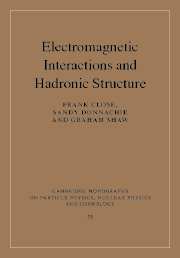Book contents
- Frontmatter
- Contents
- List of contributors
- Preface
- 1 Quark models of hadrons and issues in quark dynamics
- 2 Elastic form factors
- 3 Electromagnetic excitations of nucleon resonances
- 4 Meson radiative decays
- 5 Intermediate-energy photoproduction
- 6 Chiral perturbation theory
- 7 Spin structure functions
- 8 Diffraction and colour dipoles
- 9 Generalized parton distributions
- 10 Quark–hadron duality
- 11 Colour transparency
- Index
1 - Quark models of hadrons and issues in quark dynamics
Published online by Cambridge University Press: 15 August 2009
- Frontmatter
- Contents
- List of contributors
- Preface
- 1 Quark models of hadrons and issues in quark dynamics
- 2 Elastic form factors
- 3 Electromagnetic excitations of nucleon resonances
- 4 Meson radiative decays
- 5 Intermediate-energy photoproduction
- 6 Chiral perturbation theory
- 7 Spin structure functions
- 8 Diffraction and colour dipoles
- 9 Generalized parton distributions
- 10 Quark–hadron duality
- 11 Colour transparency
- Index
Summary
Chromostatics
The discovery of quarks in inelastic electron scattering experiments, following their hypothesized existence to explain the spectroscopy of hadrons, led rapidly to the quantum chromodynamic (QCD) theory and the Standard Model, which has underpinned particle physics for three decades. Today, all known hadrons contain quarks and/or antiquarks.
The QCD Lagrangian implies that gluons also exist, and the data for inelastic scattering at high energy and large momentum transfer confirm this. What is not yet established is the role that gluons play at low energies in the strong interaction regime characteristic of hadron spectroscopy. QCD implies that there exist ‘glueballs’, containing no quarks or antiquarks, and also quark–gluon hybrids. The electromagnetic production of hybrids is one of the aims of JLab. Glueballs, on the other hand, are not expected to have direct affinity for electromagnetic interactions; hence hadroproduction of a meson that has suppressed electromagnetic coupling is one of the ways that such states might be identified.
Quarks are fermions with spin ½ and baryon number ⅓. A baryon, with half-integer spin, thus consists of an odd number of quarks (q) and/or antiquarks (q), with a net excess of three quarks. Mesons are bosons with baryon number zero, and so must contain the same number of quarks and antiquarks.
- Type
- Chapter
- Information
- Electromagnetic Interactions and Hadronic Structure , pp. 1 - 38Publisher: Cambridge University PressPrint publication year: 2007

